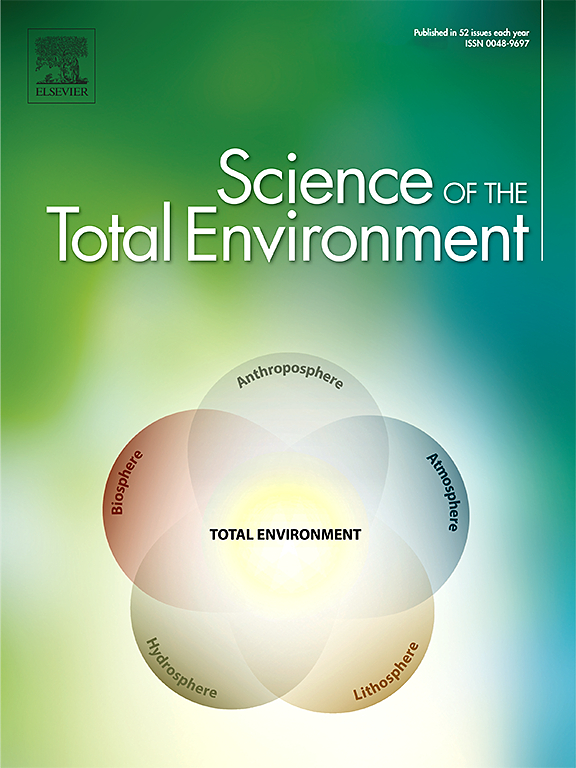Wastewater-driven nutrient enrichment restructures viral community assembly, host interactions, and ecological function along the Nakivubo–Lake Victoria interface in Uganda
IF 8.2
1区 环境科学与生态学
Q1 ENVIRONMENTAL SCIENCES
引用次数: 0
Abstract
Gulf ecosystems in freshwater lakes are dynamic interfaces of microbial activity, shaped by complex interactions between natural processes and anthropogenic inputs from surrounding urban catchments. This study investigated viral community composition, functional potential, and virus-host interactions along the Nakivubo catchment-Lake Victoria interface in Murchison Bay, Uganda. Metagenomic profiling of 28 samples across four compartments: wastewater treatment plant (WWTP); a municipal channel; papyrus-dominated wetland; and Lake water, revealed spatially distinct viromes dominated by Uroviricota (45.8–94.8 %), with higher richness observed in Channel and Wetland than in WWTP and Lake samples. Community structure was strongly compartmentalized (PERMANOVA, p < 0.001), with WWTP and Channel viromes distinct from those in less impacted compartments. Human-associated viruses, including crAss-like phages (up to 29.3 %) and Picobirnaviruses (11.4 %), were enriched in WWTP samples, reflecting fecal pollution. Linear discriminant analyses and random forest modeling identified Sinsheimervirus as wetland indicator, while Fukuivirus, Bellamyvirus and Prokaryotic dsDNA virus were characteristic of lake viromes. Viral–bacterial co-occurrence networks were fragmented and less cohesive in WWTP and Channel (average path length = 3.2), but more modular and nested in Wetland (avg. path length = 1.9; modularity = 0.47), reflecting ecological structuring. Among environmental variables, ammonia-N was the strongest correlate of viral beta diversity (Mantel r = 0.67, p < 0.01). Functionally, auxiliary metabolic genes (AMGs) linked to photosynthesis, nitrogen and carbohydrate cycling were enriched in Wetland and Lake, while mobile genetic elements (MGEs) and antibiotic resistance genes (ARGs) were largely confined to WWTP, Channel, and Wetland. These patterns suggest selective viral adaptations to eutrophic, contaminated environments and their attenuation downstream. The findings demonstrate how wastewater-driven nutrient enrichment shapes viral community assembly, host associations, and ecological function along tropical freshwater continua. Viruses emerge as sensitive indicators of anthropogenic impact and offer new perspectives for water quality monitoring and ecosystem health assessment in urban-influenced lake systems.

废水驱动的营养富集重构了乌干达Nakivubo-Lake维多利亚界面的病毒群落组装、宿主相互作用和生态功能
淡水湖的海湾生态系统是微生物活动的动态界面,由自然过程和周围城市集水区的人为输入之间的复杂相互作用形成。本研究调查了乌干达Murchison湾Nakivubo流域-维多利亚湖界面的病毒群落组成、功能潜力和病毒与宿主的相互作用。跨四个隔间28个样本的宏基因组分析:污水处理厂(WWTP);市政通道;papyrus-dominated湿地;以尿viricota为主的病毒组在空间上存在差异(45.8% ~ 94.8%),河道和湿地的病毒组丰富度高于污水池和湖泊。群落结构被强烈划分(PERMANOVA, p <;0.001),污水处理厂和通道病毒不同于那些受影响较小的隔间。人类相关病毒,包括类草噬菌体(高达29.3%)和小核糖核酸病毒(11.4%),在污水处理样品中富集,反映了粪便污染。线性判别分析和随机森林模型表明,湖病毒群的特征为Sinsheimervirus,而湖病毒群的特征为fukuvirus、Bellamyvirus和原核dsDNA virus。在WWTP和Channel中,病毒-细菌共生网络呈现碎片化、内聚性较差的特征(平均路径长度为3.2),而在湿地中,病毒-细菌共生网络呈现模块化、嵌套性较强的特征(平均路径长度为1.9);模块化= 0.47),反映了生态结构。在环境变量中,氨氮与病毒β多样性的相关性最强(Mantel r = 0.67, p <;0.01)。在功能上,与光合作用、氮和碳水化合物循环相关的辅助代谢基因(AMGs)在湿地和湖泊中富集,而移动遗传因子(MGEs)和抗生素抗性基因(ARGs)主要局限于WWTP、Channel和湿地。这些模式表明病毒对富营养化、污染环境的选择性适应及其下游的衰减。研究结果表明,废水驱动的营养富集如何影响热带淡水连续带的病毒群落组装、宿主关联和生态功能。病毒作为人类活动影响的敏感指标,为城市影响湖泊系统的水质监测和生态系统健康评价提供了新的视角。
本文章由计算机程序翻译,如有差异,请以英文原文为准。
求助全文
约1分钟内获得全文
求助全文
来源期刊

Science of the Total Environment
环境科学-环境科学
CiteScore
17.60
自引率
10.20%
发文量
8726
审稿时长
2.4 months
期刊介绍:
The Science of the Total Environment is an international journal dedicated to scientific research on the environment and its interaction with humanity. It covers a wide range of disciplines and seeks to publish innovative, hypothesis-driven, and impactful research that explores the entire environment, including the atmosphere, lithosphere, hydrosphere, biosphere, and anthroposphere.
The journal's updated Aims & Scope emphasizes the importance of interdisciplinary environmental research with broad impact. Priority is given to studies that advance fundamental understanding and explore the interconnectedness of multiple environmental spheres. Field studies are preferred, while laboratory experiments must demonstrate significant methodological advancements or mechanistic insights with direct relevance to the environment.
 求助内容:
求助内容: 应助结果提醒方式:
应助结果提醒方式:


